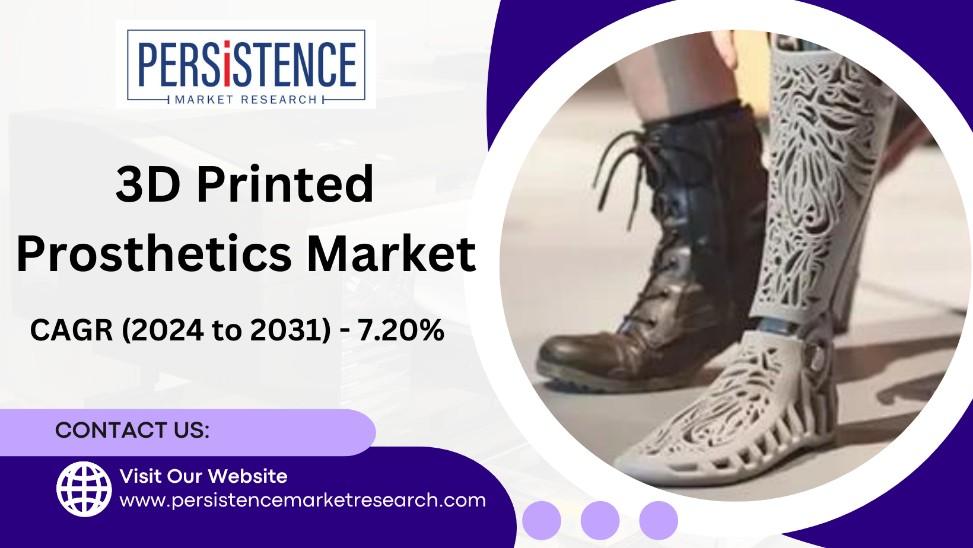Innovations in Material Science Propel Prosthetics
Market
The global 3D printed prosthetics market is set to grow from US$1.69 billion in 2024 to US$2.77 billion by 2031, with a CAGR of 7.20%. This market revolutionizes medical technology by using advanced additive manufacturing to create highly customized prosthetic limbs, enhancing comfort and mobility. Unlike traditional prosthetics, 3D printed options are more affordable and accessible, especially for underserved communities, due to streamlined production and cost reductions. This market not only represents technological advancement but also a significant shift in healthcare, empowering individuals with limb differences to regain independence and quality of life.

Rising Demand for Personalized Prosthetics
Customized Solutions for Individual Needs
Traditional prosthetic manufacturing methods are often slow, costly, and offer limited customization options. In contrast, 3D printing technology enables the creation of prosthetics tailored to each patient's unique anatomical needs. This high level of customization improves the fit, comfort, and functionality of prosthetics, significantly enhancing the quality of life for users.
Growing Incidence of Limb Loss
Globally, the incidence of limb loss due to accidents, diabetes, vascular diseases, and cancer is increasing. The Amputee Coalition reports approximately 185,000 amputations occur annually in the United States alone. This growing need for effective prosthetic solutions is a significant driver for the 3D printed prosthetics market.
Technological Advancements in 3D Printed Prosthetics
Advanced Materials Utilization
Innovations in material science are at the forefront of the advancements in 3D printed prosthetics. Modern prosthetics are made using various advanced materials, including thermoplastics, metals, and biocompatible polymers. These materials provide the necessary strength, flexibility, and biocompatibility required for effective prosthetic devices, enhancing their durability and functionality.
1. Thermoplastics: These materials are lightweight, durable, and can be easily shaped, making them ideal for creating comfortable and long-lasting prosthetics.
2. Metals: Materials such as titanium offer exceptional strength and are used in parts of prosthetics that require durability and resistance to wear.
3. Biocompatible Polymers: These materials are designed to interact safely with the human body, reducing the risk of allergic reactions or other complications.
Integration of Sensors and Electronics
3D printing technology is also enabling the integration of sensors and electronic components into prosthetics. These smart prosthetics offer real-time feedback, improving control and functionality. For example, myoelectric prosthetics use sensors to detect muscle signals, allowing users to control the prosthetic with natural muscle movements.
Rapid Prototyping and Production
3D printing facilitates rapid prototyping and production of prosthetic devices, significantly reducing development and delivery times for custom prosthetics. This speed is particularly beneficial for children, who need frequent adjustments to their prosthetics as they grow, and for quick replacement of damaged or worn-out devices.
Challenges and Opportunities
Despite the promising growth, the 3D printed prosthetics market faces several challenges that need to be addressed:
Regulatory and Quality Control Issues
Ensuring the safety and efficacy of 3D printed prosthetics is crucial. Regulatory bodies such as the FDA are working to establish guidelines and standards for the production of medical devices using 3D printing technology. Manufacturers must comply with these regulations to ensure their products meet necessary quality and safety standards.
Cost
and Accessibility
While 3D printing can reduce the cost of prosthetics, the initial investment in 3D printing equipment and materials can be high. Efforts to make this technology more accessible, particularly in smaller clinics and developing regions, are essential for expanding the reach of 3D printed prosthetics.
Training and Expertise
Producing and fitting 3D printed prosthetics require specialized training and expertise. Healthcare professionals need training in 3D printing technology and the fitting of custom prosthetics to ensure optimal patient outcomes.
Future Outlook and Market Projections
The future of the 3D printed prosthetics market is promising, with several trends expected to shape its growth:
Expansion into Developing Markets
As 3D printing technology becomes more affordable and accessible, there is significant potential for expanding 3D printed prosthetics into developing markets. These regions often face challenges in accessing high-quality prosthetic care, and 3D printing could provide a viable solution.
Continued Technological Advancements
Ongoing research and development in 3D printing technology will likely lead to further innovations in prosthetic design and production. Advances in materials science, printing techniques, and integration of electronic components will continue to enhance the functionality and affordability of 3D printed prosthetics.
Collaborations and Partnerships
Collaborations between medical device manufacturers, research institutions, and healthcare providers will play a crucial role in advancing the 3D printed prosthetics market. Partnerships can facilitate knowledge sharing, resource pooling, and expertise, driving innovation and improving patient outcomes.
Conclusion
The 3D printed prosthetics market is on a trajectory of significant growth, driven by increasing demand for customized prosthetics, advances in 3D printing technology, and the rising incidence of limb loss. With the market projected to reach $2.77 billion by 2031, it presents numerous opportunities for innovation and expansion. Addressing challenges related to regulation, cost, and expertise will be essential to fully realizing the potential of this transformative technology. The future of prosthetics looks promising, with 3D printing poised to revolutionize the industry and improve the lives of countless individuals worldwide.
